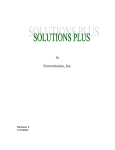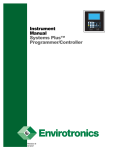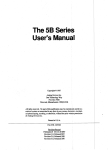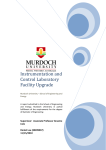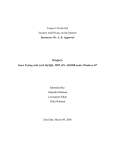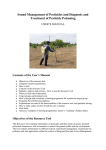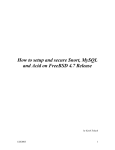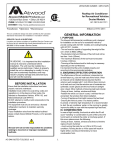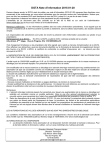Download 6B Series data sheet - MV-Sirius Hochshule Offenburg
Transcript
a ANALOG l/O FEATURES • Sensor-to-Computer Conditioning and Digitizing Complete Data Acquisition System in Each Module • PC to Backplane Communication: RS-232C • Backplane and Module Communication: RS-485 • Field Configurable via Software 6B11, 6B11HV: J, K, T, E, R, S and B Thermocouple, 615 mV to 65 V, 4-20 mA, 0-20 mA 6B12, 6B12HV: 6150 mV to 650 V, 4-20 mA, 0-20 mA 6B13, 6B13HV: 100 V Pt, 120 V Ni and 10 V Cu 6B21: 0-20 mA or 4-20 mA Output • “Simultaneous Sampling” Command Synchronizes A/D Conversion on 6B11, 6B11HV, 6B12 and 6B12HV • Configurable Parameters Stored in Module’s EEPROM • Autocalibrating, High Performance Integrating Converter, No Potentiometers Required • Linearized Outputs in Engineering Units Onboard Microcontroller Converts Digitized Thermocouple and RTD Data to Standard Units • Input to Output Isolation: 1500 V rms and 2500 V rms (HV) • Meets IEEE Standard for CMV Transient Voltage Protection (ANSI/IEEE C37.90.1-1989) • Mix and Match Module Capability Distributed, Analog and Digital I/O Signal Conditioners 6B Series • Small Package: 2.3" 3 3.1" 3 0.79" Modules Plug into Backplane • Easy to Install • Easily Removable Without Disturbing Field Wiring • All 6B Modules and Backplanes Meet the European Union’s EMC Directive and Have the CE Approval • Specifications Valid Over –258C to +858C DIGITAL l/O FEATURES • 24 Channels of Digital l/O • Interfaces with Industry Standard Solid-State Relay Panels • Readback for Output Monitoring • “Simultaneous Sampling” Command Synchronizes Input Scanning with Analog Input Modules • Bit or Byte Addressable • Communication Compatible with Analog l/O Backplanes APPLICATIONS Distributed Data Acquisition and Control Test Stand Automation Machine Monitoring Material Testing Energy Management Lab Data Acquisition REV. B Information furnished by Analog Devices is believed to be accurate and reliable. However, no responsibility is assumed by Analog Devices for its use, nor for any infringements of patents or other rights of third parties which may result from its use. No license is granted by implication or otherwise under any patent or patent rights of Analog Devices. One Technology Way, P.O. Box 9106, Norwood, MA 02062-9106, U.S.A. Tel: 617/329-4700 World Wide Web Site: http://www.analog.com Fax: 617/326-8703 © Analog Devices, Inc., 1997 6B Series GENERAL DESCRIPTION INPUT MODULES µP ACTUATORS/ OUTPUTS OUTPUT MODULES Two 6B Series Families The 6B Series of modules and backplanes are available in two families of input/output voltage isolation ratings: 1500 V rms or 2500 V rms. The 6B11, 6B12, 6B13 and 6B21 modules provide 1500 V rms continuous CMV isolation. For more demanding applications, the 6B11HV, 6B12HV and 6B13HV input modules provide 2500 V rms CMV isolation. In all other aspects, the two families provide identical performance and specifications. The 6BP01, 6BP04 and 6BP16 backplanes are used with the 6B11, 6B12, 6B13 and 6B21 modules and offer 1500 V rms channel-to-channel and input/output CMV isolation. The 6BP01 and 6BP04HV backplanes are used with the 6B11HV, 6B12HV and 6B13HV modules to provide 2500 V rms channelto-channel and input/output CMV isolation. RS-232C CONV. 4-20mA D/A HOST/ PERSONAL COMPUTER RS-485 A/D RS-485 SENSORS/ TRANSMITTERS The 6B Series of modules and boards provides the hardware needed to implement a flexible, distributed monitoring and control application. By selecting only the modules and interfaces needed and connecting them via RS-485, the data acquisition and control strategy can be designed for optimum location of the I/O as well as minimizing sensor runs. The modularity and configurability of the 6B Series also makes them very cost effective. µP BACKPLANE Figure 1. 6B Series Analog l/O Block Diagram This subsystem is completely compatible with the 6B Series protocol. Connections to 16- and 24-channel solid-state relay backplanes are via a 50 conductor ribbon cable. This allows interfacing with inputs and outputs from 4 V to 240 V. Power control modules that can switch up to three amps are also available and come with a variety of ratings for low voltage dc to 280 V ac. Similar to the analog modules, the digital I/O subsystem has an onboard microcontroller as well as nonvolatile memory. All the digital channels are addressable on a byte or bit-by-bit basis. In addition, the board can easily be configured for its address, baud rate and checksum status. Analog I/O The 6B Series analog I/O modules represent a complete “sensor to RS-485” solution. Each module performs signal conditioning, isolation, ranging, A/D or D/A conversion and digital communications. The sensors and inputs supported include thermocouples, RTDs, millivolt, volt and current signals. The output module can drive 0-20 mA or 4-20 mA interface valves or actuators. All calibration, address and linearizing parameters are stored in nonvolatile memory in the module. DESIGN FEATURES AND USER BENEFITS Simultaneous Sampling: This feature forces an input conversion to occur on all 6B11, 6B11HV, 6B12 and 6B12HV modules, and forces the 6B50 to scan its inputs at the same time. It is useful in applications requiring synchronized measurement of different input signals as well as for machine monitoring where it is important to know the sequence of events in the case of a machine failure. Designed for industrial applications, the 6B Series modules incorporate transformer-based isolation with automated surface mount manufacturing technology for increased reliability at low cost. All modules are fully encapsulated and identical in pinout and size (2.3" × 3.1" × 0.75"). The 6B Series is fully specified over the industrial temperature range of –25°C to +85°C. These compact, rugged modules can be mixed and matched on a 16-channel backplane for high density, remote data acquisition and control. Configurable: Each 6B Series module is configurable through software for many parameters including sensor type, output format, baud rate and checksum status. This can be very useful in laboratory and pilot plant environments where the temperature ranges and sensor types are not known beforehand. An additional benefit is that inventory can be greatly reduced, with fewer models of signal conditioners required for an application. High Performance: The high quality signal conditioning, combined with a precision A/D or D/A converter, delivers ± 0.05% accuracy including all temperature effects. For input modules, the auto-zeroing feature of the A/D converter assures excellent zero drift and long term stability. Unlike conventional signal conditioners, each 6B module is a complete microcomputer-based data acquisition system. A major advantage of an onboard microcontroller is the ability to reconfigure each module for various sensor types and input ranges. This reduces the number of different models that have to be used in a given application and carried in inventory. By distributing the processing needs down to the node level, the host is off-loaded for supervisory and higher level control functions. High Noise Rejection: The 6B Series was designed to accurately process low level signals in harsh industrial environments by providing up to 2500 V rms continuous transformer isolation. This also eliminates ground loops, protects against transients, and solves common mode voltage problems. The 6B input modules give 160 dB of common-mode rejection and 50 dB of normal-mode rejection. Interconnection between modules is via an RS-485 bidirectional serial bus standard. Communications between modules and host is in ASCII over an RS-232C link. Interface circuitry to convert RS-232C to RS-485 is built into the backplane. Baud rates are software programmable, and speeds up to 19.2 K baud can be selected. SOLID 50 STATE RELAY CONDUCTOR CABLE PANELS Digital I/O Digital signals can be monitored and controlled in a 6B Series RS-485 network by a 24-channel digital I/O interface board. 24-BIT LATCHES AND BUFFERS MICROCONTROLLER RS-232C CONV. HOST/ PERSONAL COMPUTER RS-485 Figure 2. 6B Series Digital I/O Block Diagram –2– REV. B Analog I/O Modules–6B Series FEATURES • Variety of Signal Source Inputs Sensors: Thermocouples and RTDs Millivolt and Voltage Sources 4-20 mA and 0-20 mA Process Current Inputs • RS-485 Output • Software Configurable for Ranges and Sensors • ”Simultaneous Sampling” Command Synchronizes A/D Conversion on 6B11 and 6B12 • All Configurable Parameters Stored in EEPROM • Linearized Output in Engineering Units • Mix and Match Input Capability • Reliable Transformer Isolation: 1500 V rms or 2500 V rms CMV, 160 dB CMR, Meets ANSI/IEEE C37.90.1–1989 CMV Transient Protection • Input Protection: 240 V rms Continuous DESCRIPTION The 6B11 and 6B11HV linearize and compensate J, K, T, E, R, S and B thermocouples, and digitize millivolt and volt ranges from ± 15 mV to ± 5 V. The 6B12 and 6B12HV interface with high level signals ranging from ± 150 mV to ± 50 V, and the 6B13 and 6B13HV linearize 100 Ω Pt (alphas of 0.00385 and 0.003916), 120 Ω Ni RTDs and 10 Ω Cu RTDs. The 6B Series input modules cover all signal ranges from ±15 mV to ± 50 V and all thermocouple and RTD types. The input signal is conditioned and scaled by the programmable gain amplifier and digitized by a 16-bit integrating converter under microprocessor control. The conversion rate is 9 samples/sec, which gives a Nyquist bandwidth of 4.5 Hz. The 6B Series modules have a simple master-slave relationship with the host, and respond only when spoken to. Each module has a unique ID number stored in nonvolatile memory for addressing. The format is ASCII, and all standard baud rates up to 19.2 K baud are possible. Refer to the communication section of the data sheet for a summary of the command set. The digitized value is serially passed across a magnetically isolated barrier (1500 V rms to 2500 V rms) and clocked in by a custom controller chip. The onboard microcontroller then converts the data into engineering units as determined by the channel parameters, i.e., whether the input signal was from a thermocouple, an RTD or a process current. Between conversions, the microcontroller auto-zeros the offset and gain by monitoring the onboard temperature and reference drift. CJC (Cold Junction Compensation) is also performed at this stage. INPUT MUX CJC INPUT PGA Each 6B Series module can be recalibrated in the field or lab to an external reference. Similarly, it can be reconfigured in the field for a different transfer function. All user configured parameters are stored in the nonvolatile memory (EEPROM) of the module. A low voltage reset monitor ensures reliable reset of the module if the supply voltage drops below 4.4 volts. RS-485 COMM PORT CHARGE BALANCING CONVERTER CUSTOM CMOS CONTROLLER CHIP MICROCONTROLLER FLOATING POWER EEPROM +5V GND Figure 3. 6B Input Module Block Diagram REV. B –3– RESET 6B Series FEATURES • Digitally Controlled Current Loop Output (12 Bits) • Programmable Output Ranges: 0–20 mA or 4–20 mA • Active Current Output; External Loop Power Supply Not Required • Common-Mode Isolation: 1500 V rms; Meets ANSI/IEEE C37.90.1-1989 for CMV Transient Protection • Normal Mode Output Protection: 240 V rms • Programmable Slew Rate Limiting • Output Monitoring and Readback for Fault Detection APPLICATIONS Distributed Data Acquisition and Control Industrial Pilot Plant Control Machine Control Energy Management RS-485 port to exchange command and status information. An EEPROM is used to store calibration constants as well as configuration information. The microcontroller also controls the output DAC through an optically isolated serial interface. The D/A converter drives the current loop through a protected V/I converter. GENERAL DESCRIPTION The 6B21 is an output module in the 6B Series that provides 0 mA–20 mA or 4 mA–20 mA process currents. It is electrically and mechanically compatible with the existing modules and backplanes. It takes a command from the host and converts it into an isolated process current suitable for interfacing with valves and actuators. The 6B21 was designed with fault protection as a key objective. In addition, the actual current flowing in the current loop can be read back by an onboard isolated A/D converter. The output monitor is a V/F converter whose frequency is proportional to the loop current. This variable signal frequency is fed back to the microcontroller through an optical isolator. The microcontroller then scales the frequency signal and returns the current readback data to the host. A DC/DC converter generates 25 V @ 25 mA from the +5 V power supply to power the current loop and output circuitry. A low voltage reset monitor ensures reliable reset of the module when the supply voltage drops below 4.7 V. In case of a brownout, the module will revert to a preset output stored in EEPROM. All 6B Series modules, including the 6B21, are encapsulated and packaged in a 2.3" × 3.1" × 0.79" module. They are fully specified over the industrial (–25°C to +85°C) temperature range. The block diagram for the 6B21 is shown in Figure 4. An onboard microcontroller communicates with the host through an RS-485 COMM PORT OPTO ISOLATION OUTPUT MONITOR MICROCONTROLLER OPTO ISOLATION RESET D/A CONVERTER PROTECTED OUTPUT STAGE RL EEPROM +5V GND OSC. AND DRIVERS ISOLATED POWER SUPPLIES Figure 4. 6B21 Block Diagram –4– REV. B Digital I/O–6B Series FEATURES • 24 Channels of Digital l/O • Interfaces with Industry Standard Digital l/O Panels • High Output Current Capability • RS-232C Interface to Host (6B50-2) • RS-485 Interface to Other 6B Series Backplanes • Instruction Set Compatible with 6B Series • “Simultaneous Sampling” Command Synchronizes Input Scanning with Analog Input Modules • Readback for Output Monitoring APPLICATIONS Distributed Data Acquisition and Control Industrial Pilot Plant Control Machine Control Energy Management Similar to other 6B Series backplanes, the 6B50 is available with only an RS-485 interface (6B50-1), or with an additional RS-485/ RS-232C converter (6B50-2). The 6B50 is a 3.47" × 6.5" open board that can be panel or rack mounted. It is fully specified over the commercial (0°C to +70°C) temperature range. GENERAL DESCRIPTION The 6B50 is a digital I/O board that is compatible with the 6B Series at the network level. It takes a command from the host and converts it into logic levels suitable for interfacing with industry standard optoisolated digital I/O panels. All I/O channels can be configured for input or output, using bit or byte addressing. In addition, the status of the port can be read back by the host to confirm the I/O configuration. INTERFACING The 6B50 interfaces with industry standard single and quad solid-state relay modules. These are available for use with inputs and outputs from 4 V to 240 V. Power control modules can switch up to three amps and are available in a variety of ratings for low voltage dc to 280 V ac. Analog Devices also supplies 16- and 24-channel digital subsystems (DB-16 and DB-24) that interface with the 6B50 through a 50 conductor flat ribbon cable. The block diagram for the 6B50 is shown below. An onboard microcontroller communicates with the host to exchange command and status information. An EEPROM is used to store system parameters (address, baud rate, etc.) as well as I/O configuration information. The microcontroller is interfaced to 8-bit latches and buffers for a maximum of 24 digital I/O channels. Each channel can be individually set as an input or output. RS-232C/RS-485 CONVERTER (6B50-2) RS-485 COMM PORT The single-channel modules listed below plug into the DB-16 board. 50-PIN FLAT CABLE CONNECTOR 24-BIT LATCH PROM MICROCONTROLLER 24-BIT INPUT BUFFER RESET Model Range IA140A IA280A OA140A OA280A ID016 ID032 OD060 AC Input, 140 V AC Input, 280 V AC Output, 140 V AC Output, 280 V DC Input, 16 V DC Input, 32 V DC Output, 60 V The quad modules listed below plug into the DB-24 board. Model Range OA240QA OD60Q IA120QA IA240QA ID32Q ID16FQ 4-Channel Output, 120 V/240 V ac 4-Channel Output, 60 V dc Input, 120 V ac or dc 4-Channel Input, 240 V ac or dc 4-Channel Input, 10 V–32 V dc 4-Channel Fast Input, 16 V dc 50 µs Turn-On Time, 100 µs Turn-Off Time EEPROM +5V GND OSC Figure 5. 6B50 Block Diagram REV. B –5– 6B Series BACKPLANES Backplane Description Dynamic Data Exchange (DDE) support for the 6B Series is available from KEPware, Inc.® KEPware’s 32-bit 6B Series device driver works in conjunction with KEPware’s DDE Server (KEPDDE) to exchange data between DDE clients and 6B Series modules. The KEPware DDE server supports NetDDE, Advanced DDE, FastDDE, XL_Table, and CF_Text. Please refer to the 6B Series User’s Manual for additional information. The 6B Series backplanes, combined with modules, provide a complete data acquisition system for end users. Each backplane incorporates screw terminals for field wiring inputs and outputs and cold junction compensation for thermocouple applications. The communication interface is RS-232C to host PC and RS-485 between backplanes. COMMUNICATIONS For flexibility in application, one, four and sixteen channel backplanes are provided. These can be ordered either with the standard RS-485 interface or with the optional RS-232C to RS-485 converter. The RS-232C interface allows easy hookup to most serial ports, while the standard RS-485 interface can be used for daisy chaining additional backplanes. The RS-485 interface can drive a twisted pair cable up to a maximum of 4000 ft. All 6B Series backplanes require a +5 V ± 5% power supply for the backplane circuitry as well as the modules. A backplane (four channel or sixteen channel) and a power supply can be easily mounted on the AC1380 nineteen-inch rack mount kit. All communications with 6B Series module subsystems consist of commands generated by the host computer and responses transmitted by the 6B Series modules. A “party line” system is employed; all commands to the modules must contain an address, and only the addressed module will reply. All characters transmitted or received from a module are composed of a subset of printable ASCII characters. Command Set The following syntax is used to define the instruction set. All arguments are two-character hexadecimal ASCII. (AA) The current address of the target module. The valid range of addresses is 00(hex) to FF(hex). (NN) The new address to which the module will be reconfigured. (TT) The range code to be configured. (CC) The baud rate to be configured. Valid codes range from 01 (300 baud) to 07 (19.2K baud). (FF) The code for the data format, integration time and checksum status. (CR) ASCII Carriage Return. Table I. Backplane Specifications Model Chan- Internels face* Isolation Dimensions Power Consumption 6BP01-1 6BP01-2 6BP04-1 6BP04-2 6BP04HV-1 6BP04HV-2 6BP16-1 6BP16-2 1 1 4 4 4 4 16 16 2500 V rms 2500 V rms 1500 V rms 1500 V rms 2500 V rms 2500 V rms 1500 V rms 1500 V rms 4.25" × 1.37" 4.25" × 2.85" 3.47" × 6.5" 3.47" × 6.5" 3.47" × 6.5" 3.47" × 6.5" 3.47" × 17.4" 3.47" × 17.4" Passive 150 mA 150 mA 150 mA 150 mA 150 mA 150 mA 150 mA RS-485 RS-232C RS-485 RS-232C RS-485 RS-232C RS-485 RS-232C 6B Input Module Commands Read Data Configuration Span Calibration Offset Calibration Configuration Status CJC Data Simultaneous Sampling Read Synchronized Data *All backplanes have the RS-485, half duplex, interface. CONFIG JUMPER W1 RS-232C TO/FROM HOST COMPUTER. RS-232C TO RS-485 CONVERTER CR2 CR3 RTS LED RS-485 REPEATER DATA LED +5 VOLTS GROUND FIELD TERMINATION BLOCK #(AA)(CR) %(AA)(NN)(TT)(CC)(FF)(CR) $(AA)0/(CR) $(AA)1(CR) $(AA)2(CR) $(AA)3(CR) #(**) $(AA)(CR) 6B Input Module Responses 50Ω CJC SENSOR CURRENT SENSE RESISTOR SOCKET Data Config or Cal OK Config or Cal Error Configuration Status RS-485 TO NEXT BACKPLANE: ALL SUBSEQUENT BACKPLANES MUST BE RS-485 INTERFACE ONLY Figure 6. 6BP16-2 Block Diagram SOFTWARE SUPPORT >(data)(CR) !(AA)(CR) ?(AA)(CR) !(AA)(TT)(CC)(FF)(CR) 6B Output Module Commands/Responses Utility Disk: A DOS-based “Sixbccd” program and Windowsbased “6B-Win” program are included with the AC1383 (6B Series User’s Manual). Either program is used to configure, calibrate, test and evaluate the 6B-Series modules. Drivers: Drivers for popular application software packages, available from third party vendors, require little or no programming on the part of the user prior to configuring and running an application package. Applications range from simple data collection and analysis to real-time process control and monitoring. Operating platforms include DOS, Windows®3.1, Windows®95 and Windows®NT. Drivers are currently available for: LabVIEW™, LabWindows/CVI™ and BridgeVIEW™ from National Instruments, LABTECH NOTEBOOK™ and CONTROL™ from Laboratory Technologies Corporation and the FIX™ from Intellution, Inc. Out Data Data Received #(AA)(data)(CR) >(CR) Low Cal Hi Cal Count Up/Down Store Startup Current $(AA)0/(CR) $(AA)1(CR) $(AA)3(number of bits)(CR) $(AA)4(CR) Read Reset Status Reset Status $(AA)5(CR) !(AA)S(CR) Return Last Value Last Value $(AA)6(CR) !(AA)(data)(CR) Read Current Loop Current in Loop $(AA)8(CR) !(AA)(data)(CR) All trademarks are the property of their respective holders. –6– REV. B Communications–6B Series Digital I/O Commands/Responses In addition to the standard CONFIG command for the 6B Series, the following commands and responses are specific to the 6B50: Digital Data Out Response #AABBDD(CR) >(CR) Simultaneous Sampling Response #** None Digital Data In Synchronized Data In Response $AA6(CR) $AA4(CR) !DDDDDD(CR) Reset Status Response $AA5(CR) !AAS(CR) S indicates the reset status of the module. If S = 1, the module has been reset since the last time the Reset Status command was executed. Input Module Data Formats 6B Series input modules may be configured to transmit their data in any of three different formats. The formats are: Engineering Units: This format scales all data to the natural units of the particular range such as volts, millivolts, milliamperes or degrees C. Data is presented in a signed, fixed digit decimal format; the format consists of a “+” or “–” sign, followed by five decimal digits and a decimal point whose position varies according to the specifications associated with the configured range. The syntax is: (sign)(5 digits plus decimal point) Percent of Full Scale: In this format the span is scaled to ± 100%; therefore, the data returned indicates the value of the input signal relative to the calibrated full-scale range of the input. The decimal point is fixed, and the maximum resolution is ± 0.01%. The syntax is: Percent of Full Scale: In this format, the span is scaled to 0%–100%. For the 0 mA–20 mA range, the permissible span is 0% to +110%, and for the 4 mA–20 mA range, the span is –20% to +110%. The syntax is: (sign)NNN.nn Hexadecimal Binary: This format is the most compact with the least resolution. The data is presented as a three character hexadecimal string, representing a binary value. Positive full scale (20 mA) is represented as FFF, and the minimum value of the range (0 mA or 4 mA) is represented as 000. The syntax is: HHH Optional Checksum Generation/Checking Checksum can be enabled to improve the detection of errors and make communications more reliable. The syntax described previously assumes checksum disabled. When enabled, the modulo-256 sum of the message (expressed in two character hexadecimal form) is added at the end, before the carriage return. “Simultaneous Sampling” Command This is an unaddressed command that forces an input conversion to occur on all 6B11 and 6B12 modules and forces the 6B50 to scan its inputs. The data is held in a separate register and can be retrieved using a separate data command. See User’s Manual for more details. Selecting the Integration Time (Analog Input Modules Only) The 6B Series input modules can be configured for two different integration times to maximize normal mode rejection of line noise. For applications in the U.S.A. (60 Hz), the integration time may be set for 50 milliseconds; and in Europe (50 Hz), it may be set for 60 milliseconds. This corresponds to three line cycles and results in a throughput of 9.5 conv/sec or 8.33 conv/sec, respectively. (sign)(DDD.DD) where D is a decimal digit. The Twos Complement Hexadecimal Binary Format: This format is the most compact and provides the most resolution. The data is presented as a four character hexadecimal string, representing a twos complement binary value. Positive full scale is represented as “7FFF” (+32,767) and negative full scale as “80/ 0/ 0/” ( –32,768). The syntax is: 7 6 5 4 3 2 T (int) CHECK SUM SLEW SLEW SLEW SLEW 1 6B21 ONLY 0: CHECKSUM DISABLED 1: CHECKSUM ENABLED 0: T (int) = 50ms (60Hz Operation) 1: T (int) = 60ms (50Hz Operation) (HHHH) where H is a hexadecimal character. 0 FORMAT FORMAT ANALOG INPUTS ONLY 00: ENGINEERING UNITS 01: % OF FS 10: HEX BINARY 11: ERROR OR OHMS (6B13) 0000: IMMEDIATE 0001: 0.125mA/sec 0010: 0.250 0011: 0.500 0100: 1 0101: 2 0110: 4 0111: 8 1000: 16 1001: 32 1010: 64 1011: 128 Output Module Data Formats Figure 7. Configuration Character The 6B21 may be configured to communicate data in any of three different formats. The formats are: Engineering Units: Data is presented in a decimal format consisting of five digits and a fixed decimal point. This format provides the most resolution. The range is 0 mA to 22 mA. The syntax is: NN.nnn REV. B –7– 6B Series Input Module Specifications (Typical @ +258C and +5 V power) Model 6B11, 6B11HV Input Types Thermocouple, mV, V, mA Output RS-485 ± 0.05% or Better Accuracy1 Zero Drift ± 0.3 µV/°C Span Drift ± 3 ppm/°C (± 25 ppm/°C max) Common-Mode Voltage, Input to Output 1500 V rms Continuous 2500 V rms (HV) Common-Mode Rejection @ 50 Hz or 60 Hz 160 dB 1 kΩ Source Imbalance Normal-Mode Rejection @ 50 Hz or 60 Hz 58 dB Differential Input Protection 240 V rms Continuous Input Transient Protection (CMV) ANSI/IEEE C37.90.1-1989 Input Resistance 100 MΩ Bandwidth 4 Hz Conversion Rate 9 samples/sec Power Consumption 0.5 W 6B12, 6B12HV 6B13, 6B13HV mV, V, mA Pt, Ni, Cu RTD * * * ± 10 ppm/°C (± 50 ppm/°C max) * ** 108 dB * ± 0.03°C (Pt, Ni) 56 dB * * 1 MΩ * * * } Combined Effect: ± 0.005°C/°C * ** * * * * N/A * * * Output Module Specifications (Typical @ +258C and +5 V power unless otherwise noted) Model OUTPUT SPECIFICATIONS Ranges Overrange Initial Accuracy Output Offset Span Accuracy vs. Temperature Output Offset TC Gain TC Resolution Nonlinearity Bandwidth Settling Time Noise (100 Hz Bandwidth) Load Resistor Normal-Mode Protection Slew Rate 6B21 0–20 mA, 4–20 mA +2 mA ± 200 µA ± 5 µA (± 15 µA max) ± 0.02% FSR (± 0.05% FSR max) ± 1 µA/°C ± 50 ppm/°C ± 0.02% FSR ± 0.02% FSR 100 samples/sec 1 ms to 0.1% FSR 1 µA p-p 0 Ω to 750 Ω 240 V rms Step Response Plus 0.125 mA–128 mA/sec in Eleven Binary Ranges READBACK SPECIFICATIONS Initial Accuracy Output Offset Span Accuracy vs. Temperature Output Offset TC Gain TC Resolution Nonlinearity ± 5 µA/°C ± 200 ppm/°C ± 0.5% FSR ± 0.5% FSR ISOLATION SPECIFICATIONS Common-Mode Voltage Input to Output CMR @ 60 Hz Transient Protection 1500 V rms 90 dB min ANSI/IEEE C37.90.1-1989 POWER CONSUMPTION 1.2 W ± 100 µA ± 0.5% FSR NOTES 1 See Range Accuracy table on next page for specific accuracy by range. *Specifications same as 6B11. **Specifications same as 6B11HV. Specifications subject to change without notice. –8– REV. B 6B Series Range Accuracy (Typical @ +258C and +5 V power) Hex Code Range Description Typical Accuracy1 Maximum Error1 Peak-to-Peak Noise Units 00 01 02 03 04 05 06 0E 0F 10 11 12 13 14 6B11, 6B11HV ± 15 mV ± 50 mV ± 100 mV ± 500 mV ±1 V ±5 V ± 20 mA2 J Thermocouple, 0°C to 760°C K Thermocouple, 0°C to 1000°C T Thermocouple, –100°C to 400°C E Thermocouple, 0°C to 1000°C R Thermocouple, 500°C to 1750°C S Thermocouple, 500°C to 1750°C B Thermocouple, 500°C to 1800°C ± 0.03 +0.015 ± 0.0055 ± 0.005 ± 0.005 ± 0.005 ± 0.008 ± 0.4 ± 0.5 ± 0.5 ± 0.5 ± 0.63 ± 0.62 ± 1.2 ± 0.06 ± 0.04 ± 0.03 ± 0.03 ± 0.03 ± 0.03 ± 0.03 ± 0.75 ± 0.75 ± 0.75 ± 0.75 ± 1.5 ± 1.5 ± 2.0 ± 0.02 ± 0.01 ± 0.005 ± 0.002 ± 0.005 ± 0.0015 ± 0.005 ± 0.14 ± 0.22 ± 0.2 ± 0.2 ± 0.3 ± 0.4 ± 0.7 % of FS % of FS % of FS % of FS % of FS % of FS % of FS °C °C °C °C °C °C °C 07 08 09 0A 0B 0C 0D 6B12, 6B12HV ± 50 V ± 10 V ±5 V ±1 V ± 500 mV ± 150 mV ± 20 mA2 ± 0.006 ± 0.006 ± 0.006 ± 0.006 ± 0.01 ± 0.03 ± 0.006 ± 0.03 ± 0.03 ± 0.03 ± 0.03 ± 0.04 ± 0.06 ± 0.03 ± 0.004 ± 0.005 ± 0.006 ± 0.007 ± 0.008 ± 0.02 ± 0.007 % of FS % of FS % of FS % of FS % of FS % of FS % of FS 20 21 22 23 24 25 26 27 28 29 2A 2B 6B13, 6B13HV Pt, –100°C to +100°C, a = 0.00385 Pt, 0°C to +100°C, a = 0.00385 Pt, 0°C to +200°C, a = 0.00385 Pt, 0°C to +600°C, a = 0.00385 Pt, –100°C to +100°C, a = 0.003916 Pt, 0°C to +100°C, a = 0.003916 Pt, 0°C to +200°C, a = 0.003916 Pt, 0°C to +600°C, a = 0.003916 Ni, –80°C to +100°C Ni, 0°C to +100°C Cu, 0°C to +120°C, = 0 Ω @ 25°C Cu, 0°C to +120°C, = 10 Ω @ 25°C 0.02 0.03 0.03 0.05 0.03 0.05 0.03 0.04 0.05 0.03 0.13 0.11 0.15 0.15 0.15 0.15 0.15 0.15 0.15 0.15 0.15 0.15 1.4 1.4 0.03 0.04 0.04 0.05 0.03 0.03 0.04 0.05 0.02 0.02 0.04 0.04 °C °C °C °C °C °C °C °C °C °C °C °C ± 0.25 ± 0.5 ± 0.0125 ± 0.75 See Note 1 AC1361 (CJC Sensor) @ +25°C Ambient Over +5°C to +45°C Ambient °C °C °C/°C NOTES 1 Module only. When measuring thermocouple signals, the CJC sensor accuracy should be added to the 6B11 and 6B11HV module accuracy to compute the average system accuracy. The AC1361 CJC sensor is provided on each channel of the 6B Series backplanes. 2 Excluding error contribution from current sense resistor. Common Module Specifications POWER SUPPLY Voltage, Operating +5 V dc ± 5% (+6.5 V dc max) SIZE 2.3" × 3.1" × 0.79" (58.4 × 78.7 × 19.1 mm) ENVIRONMENTAL Temperature Range Rated Performance Storage Relative Humidity (MIL-STD-883C, Method 1004.4) REV. B –25°C to +85°C –40°C to +85°C 0°C to 95% @ +60°C –9– 6B Series Digital I/O Specifications (Typical @ +258C and +5 V power unless otherwise noted) Model 6B50 DIGITAL I/O Number of I/O I/O Circuit Configuration Digital Inputs High Level Input Low Level Input Digital Outputs High Level Output Current Low Level Output Current High Level Output Voltage 24 (Configurable for Input or Output) Open Collector Outputs with 47 kΩ Pullups to +5 V 3.5 V min, 5.25 V max 0.8 V max 50 µA @ 5 V 100 mA @ 1.1 V 5.25 V max COMMUNICATIONS RS-232C (6B50-2) Baud Rates Maximum Distance RS-485 Baud Rates Maximum Distance 300, 600, 1200, 2400, 4800, 9600, 19.2 K 50 ft. 300, 600, 1200, 2400, 4800, 9600, 19.2 K 4000 ft. POWER SUPPLY Voltage, Operating Voltage, Max Safe Limit Current, Quiescent +5 V ± 5% +6.5 V dc 100 mA* SIZE 3.47" × 6.5" (90.68 mm × 165.1 mm) ENVIRONMENTAL Temperature Range Rated Performance Storage Relative Humidity 0 to +70°C –40°C to +85°C 0 to 95% NOTES *Excluding load current. Specifications subject to change without notice. CAUTION ESD (electrostatic discharge) sensitive device. Electrostatic charges as high as 4000 V readily accumulate on the human body and test equipment and can discharge without detection. Although the 6B Series features proprietary ESD protection circuitry, permanent damage may occur on devices subjected to high energy electrostatic discharges. Therefore, proper ESD precautions are recommended to avoid performance degradation or loss of functionality. WARNING! ESD SENSITIVE DEVICE RS-485 FROM PREVIOUS BACKPLANE (ON 6B50-1 ONLY) RS-232C (ON 6B50-2 ONLY) +5 VOLTS DC POWER 50-PIN FLAT CABLE CONNECTOR 50 CONDUCTOR CABLE (CAB-03) DB-16 OR DB-24 BACKPLANE RS-485 TO NEXT BACKPLANE Figure 8. 6B50 Digital I/O Board Block Diagram –10– REV. B 6B Series 6B Module Outline Pin Designations NC 25 XCV– 23 RTS– 21 PWR COM 19 NC 25 XCV– 23 RTS– 21 XCV+ 24 22 RTS+ 20 +5V PWR 18 CONFIG PWR COM 19 6B11 6B12 6B11HV 6B12HV 3.020 (76.71) IN LO 7 –EXC 5 CJC EXC 3 –SNS 1 6 IN HI 4 +EXC 2 +SNS NC 25 XCV– 23 RTS– 21 0.170 (4.32) 0.220 (5.59) 0.320 (8.13) +5V PWR 18 CONFIG LO 7 NC 5 NC 3 NC 1 6 HI 4 NC 2 NC 19 24 XCV+ 22 RTS+ 20 +5V PWR 18 CONFIG 6B13 6B13HV 0.790 (20.07) 2.280 (57.91) RTS+ 20 TOP VIEW NC = NO CONNECT PWR COM 1.115 (28.32) XCV+ 22 6B21 TOP VIEW NC = NO CONNECT 0.350 0.475 (8.89) (12.07) 24 RTD COM 7 NC 5 NC 3 NC 1 6 +SNS 4 +SRC 2 NC TOP VIEW NC = NO CONNECT 1 1 2 2 3 50Ω 1 LO 3 2 LO 3 HI 1 1 2 2 3 RL 3 HI 4 PLUG IN RESISTOR (AC1381) 4-20mA 4 4 2 WIRE THERMOCOUPLE mV,V INPUT CONNECTIONS 4 RTD OUTPUT CONNECTIONS Figure 9. 6B Series Connections REV. B 4 3 & 4 WIRE –11– 6B Series–Ordering Guide Worksheet MODULES Module Selection: Determine the types and number of 6B Series modules based on sensor inputs. The following table lists the sensors and ranges covered by each module. Module Range 6B11, 6B11HV Thermocouples: Voltage Inputs: Current Inputs: 6B12, 6B12HV Voltage Inputs: Current Inputs: BACKPLANES 6BP01-1 J, K, T, E, R, S & B ± 15 mV, ± 50 mV, ± 100 mV, ± 500 mV, ± 1 V, ± 5 V ± 20 mA (4-20 mA is a subset of this.) ± 150 mV, ± 500 mV, ± 1 V, ± 5 V, ± 10 V, ± 50 V ± 20 mA (4-20 mA is a subset of this.) 6B13 6B13HV RTDs: Pt 100 Ω, ∞ = 0.003916 or 0.00385 Ni 120 Ω, Cu 10 Ω 6B21 Current Output: 0-20 mA, 4-20 mA Backplane Selection: Determine the backplanes you need according to the number of modules chosen, the required channel-to-channel isolation and the clustering of sensors. If the host interface is RS-232C, then one backplane must have the RS-232C option for connecting to the host. All subsequent daisy-chained backplanes must use the RS-485 interface. The available backplanes are as follows: 6BP01-1 One-channel backplane with one RS-485 interface only. Mountable in a 40 mm × 111 mm DIN holder. Requires +5 V power. Dimensions: 1.37" × 4.25" 6BP01-2 One-channel backplane with one RS-232C interface for a host connection and one RS-485 interface for daisychaining. Mountable in a 75 mm × 111 mm DIN holder. Requires +5 V power. Dimensions: 2.85" × 4.25" 6BP01-2 6BP04-1 Four-channel backplane with two RS-485 ports: one for connecting to the previous backplane (or host) and the other for connecting to the next backplane in the daisy chain (up to 4000 feet away). Backplane current requirement: 200 mA @ +5 V (excluding modules). 6BP04HV-1 Same as 6BP04-1, but Isolation Voltage (input-to-output and channel-to-channel) is 2500 V rms (vs. 1500 V rms), and Power Supply Overvoltage Protection (>6.5 V dc) is provided. 6BP04-1 6BP04HV-1 –12– REV. B 6B Series 6BP04-2 Four-channel backplane with an RS-232C interface for host connection and an RS-485 interface to connect to the next backplane in the daisy chain (up to 4000 feet away). Backplane current requirement: 200 mA @ +5 V (excluding modules). 6BP04HV-2 Same as 6BP04-2, but Isolation Voltage (input-to-output and channel to channel) is 2500 V rms (vs. 1500 V rms), and Power Supply Overvoltage Protection (>6.5 V dc) is provided. Dimensions: 3.47" × 6.5" 6BP16-1 16-channel backplane. System interface same as 6BP04-1. Power requirement also 200 mA @ +5 V. 6BP16-2 16-channel backplane. System interface same as 6BP04-2. Requires 200 mA @ +5 V for backplane (excluding modules). Dimensions: 3.47" × 17.4" 6BP04-2 6BP04HV-2 6BP16-1 6BP16-2 DIGITAL I/O 6B50-1 The 6B50 provides 24 channels of digital I/O in a 6B Series network. All channels can be individually configured for input or output using bit or byte addressing. The 50-pin connector on the board interfaces with industry-standard, solid-state relays (single as well as quad modules). 6B50-1 24-channel digital I/O board with RS-485 input and output screw terminals. Requires 225 mA @ +5 V. Dimensions: 3.47" × 6.5" 6B50-2 24-channel digital I/O board with an RS-232C port for interfacing with the host and a RS-485 port for expansion. Require 225 mA @ +5 V. Dimensions: 3.47" × 6.5" 6B50-2 REV. B –13– 6B Series DIRECT TTL CONNECTION STB-50A This panel provides screw terminals for direct connection to all 24 TTL-level discrete I/O channels. It connects to the 6B50 with a 3-foot ribbon cable (included). Dimensions: 3" × 5.25" DB-16 Provides isolated connection of high level ac or dc voltage inputs or outputs to 16 digital I/O channels. Accommodates single channel modules. Order a CAB-03 cable with each DB-16. Dimensions: 3.5" × 14.05" DB-24 Provides isolated connection of high-level ac or dc voltage inputs or outputs to 24 digital I/O channels. Accommodates quad solid-state relay modules. Order a CAB-03 cable with each DB-24. Dimensions: 6.0" × 8.0" STB-50A SOLID-STATE RELAY CONNECTION DB-16 DB-24 The single channel modules listed below plug into the DB-16 board. SOLID-STATE RELAY MODULES Model Range IA140A IA280A OA140A OA280A ID016 ID032 OD060 AC Input, 140 V AC Input, 280 V AC Output, 140 V AC Output, 280 V DC Input, 16 V DC Input, 32 V DC Output, 60 V The quad modules listed below plug into the DB-24 board. Model Range OA240QA OD60Q IA120QA IA240QA ID32Q ID16FQ 4-Channel Output, 240 V ac 4-Channel Output, 60 V dc 4-Channel Input, 120 V ac or dc 4-Channel Input, 240 V ac or dc 4-Channel Input, 10 V–60 V dc 4-Channel Fast Input, 16 V dc 50 µs Turn-On Time, 100 µs Turn-Off Time –14– REV. B 6B Series Power Supply Selection: Determine the power supplies you need according to how backplanes are grouped. All power supplies are chassis mountable. The available power supplies are as follows: POWER SUPPLIES MODELS 955 AND 977 Model Amps Description V ac In 955 977 PWR-01 AC1340-D 1A 5A 5A Suitable for Up to 6 Input Modules Suitable for Up to 32 Input Modules Suitable for Up to 32 Input Modules Power Cord (U.S.) 110 110 110/220 110 Dimensions: 2.7" × 4.0" × 1.45" (955,977) 2.76" × 4.7" × 1.38" (PWR-01) PWR-01 RACK-MOUNT KITS AC1380: The rack-mount kit mounts in a 19-inch rack and occupies 3 1/2 inches of rack space. It will hold one 4-channel or 16-channel backplane. The power supplies can be mounted on the underside of the rack mount. OPTIONAL POWER SUPPLY AC1380 RACK MOUNT 6B SERIES BACKPLANE RM-02: This rack-mount kit mounts in a 19-inch rack and occupies 7 inches of rack space. It can hold a DB-24 backplane. RM-02 REV. B –15– 6B Series ACCESSORIES AC1361: This SIP (Single-In-Line-Package) temperature sensor provides cold junction temperature measurements for thermocouple applications on user designed backplanes. These sensors are provided on each channel of the 6B backplanes. AC1381: This is a 50 Ω current conversion resistor that plugs into the backplane. One AC1381 is required for each 4-20 mA/0-20 mA input channel of the backplane. AC1382: This cable connects to most PC serial ports. Only Pins 2, 3 and 7 (connected one-to-one) are required for operation. AC1385: This cable connects to some 9-pin PC serial ports: Pins 2, 3 and 5 on the 9-pin connector are connected to 3, 2 and 7 on the 25-pin connector. CAB-03: This is a 50-pin ribbon cable that connects the 6B50 to a DB-16 or DB-24 backplane. SOFTWARE/DOCUMENTATION 6B Series Configuration Disk and Manual (AC1383): The disk is useful for configuring the address, baud rate and range of the 6B Series modules. The AC1383 software supports DOS, Windows 3.1, Windows 95 and Windows NT. Application Software: Drivers for the following software packages are available directly from the vendor. LabVIEW, LabWindows/CVI, BridgeVIEW from National Instruments in Austin, TX; LABTECH NOTEBOOK and CONTROL from Laboratory Technologies Corporation in Wilmington, MA; THE FIX from Intellution in Norwood, MA. –16– REV. B 6B Series TYPICAL CONFIGURATIONS To assemble a complete 6B Series system, first consider grouping the sensors to use the daisy-chaining capability of the system. (This will reduce sensor wire routing and simplify host communication.) Then, select the following components of the system: 1. Hardware – 6B Series Modules – 6B Series Backplanes – Power Supplies and Power Supply Cords 2. Accessories – RS-232C Cable to Host – Belden Cable to Interconnect Backplanes with RS-485 (Belden P/N9729) – Current Conversion Resistor (AC1381) – Rack-Mount Kit for 19-inch Rack 3. Software – 6B Series Configuration Disk – Application Software. Drivers for the following software packages are available directly from the vendor. – LabVIEW, LabWindows/CVI, BridgeVIEW from National Instruments in Austin, TX; LABTECH – NOTEBOOK and CONTROL from Laboratory Technologies Corporation in Wilmington, MA; THE FIX – from Intellution in Norwood, MA. RS-232C CABLE (AC1385) +5V POWER SUPPLY MODEL 955 AC POWER CORD (AC1340-D) SENSOR 6BP01-2 Figure 10. One-Channel 6B Series Setup Minimum Configuration. The setup in Figure 10 can be used to evaluate or configure a 6B Series analog module. The 6BP01-2 can also be used as an RS-232 to RS-485 converter for applications that require the first set of modules to be up to 4000 feet from the host. The 6BP01-2 does not require a module to function as a converter. REV. B –17– 6B Series HOST COMPUTER DB-24 DIGITAL I/O BACKPLANE RS-232C PWR 6B50-1 6BP16-2 PWR RS-485 RS-485 6BP16-1 PWR PWR 6BP04-1 (6BP04HV-1) RS-485 PWR PWR 6BP01-1 6BP04-1 (6BP04HV-1) PWR 6BP01-1 PWR 6BP01-1 Figure 11. Multiple-Backplane Configuration Multiple-Backplane Configuration In a setup similar to Figure 11, the following constraints on the RS-485 must be observed: 1. Maximum cable length between backplanes with repeaters (6BP04 and 6BP16) is 4000 feet. 2. Maximum loads on a segment between repeaters is 32 (1 load = one module or one 6B50). The recommended cable for RS-485 is a dual twisted-pair with foil shield and drain (such as Belden P/N 9842). –18– REV. B 6B Series Model Description Module 6B11, 6B11HV 6B12, 6B12HV 6B13, 6B13HV 6B21 Isolated Thermocouple, mV/V, mA Input Isolated V, mA Input Isolated RTD Input Isolated Current Output Backplane 6BP01-1 6BP01-2 6BP04-1, 6BP04HV-1 6BP04-2, 6BP04HV-2 6BP16-1 6BP16-2 Single-Channel Backplane with RS-485 Interface Single-Channel Backplane with RS-485 and RS-232C Interfaces 4-Channel Backplane with RS-485 Interface 4-Channel Backplane with RS-485 and RS-232C Interfaces 16-Channel Backplane with RS-485 Interface 16-Channel Backplane with RS-485 and RS-232C Interfaces Digital I/O 6B50-1 6B50-2 STB-50A DB-16 DB-24 IA140A IA280A OA140A OA280A ID016 ID032 OD060 OD200 OA240QA OD60Q IA120QA IA240QA ID32Q ID16FQ 24-Channel Backplane with RS-485 Interface 24-Channel Digital I/O with RS-232C and RS-485 Interface Termination Panel for Digital I/O, DIN Rail Mounting 16-Channel Digital I/O Backplane (Single-Channel Modules) 24-Channel Digital I/O Backplane (Quad-Channel Modules) Single-Channel Modules for the DB-16 Backplane AC Input, 140 V AC Input, 280 V AC Output 140 V AC Output, 280 V DC Input, 16 V DC Input, 32 V DC Output, 60 V DC Output, 200 V Quad-Channel Modules for the DB-24 Backplane 4-Channel Output, 240 V ac 4-Channel Output, 60 V dc 4-Channel Input, 120 V ac 4-Channel Input, 10–32 V dc 4-Channel Input, 16 V dc 4-Channel Fast Input, 16 V dc 50 µs Turn-On Time, 100 µs Turn-Off Time Power Supplies 955 977 PWR-01 +5 V @ 1 A Power Supply +5 V @ 5 A Power Supply +5 V @ 5 A Power Supply (Wide Input Range: 85 V ac to 265 V ac) Accessories AC1361 AC1380 AC1381 AC1382 AC1383 AC1340-D CAB-03 Temperature Sensor for Cold Junction Compensation 19-Inch Rack Mount 50 Ω Current Conversion Resistor RS-232C Cable 6B Series User’s Manual and Configuration Disk Power Cord (U.S.) 50-Pin Ribbon Cable, Connects 6B50 to DB-16 or DB-24 REV. B –19– –20– PRINTED IN U.S.A. C1244b–12–4/97




















